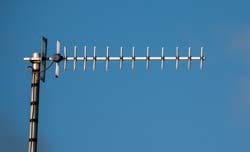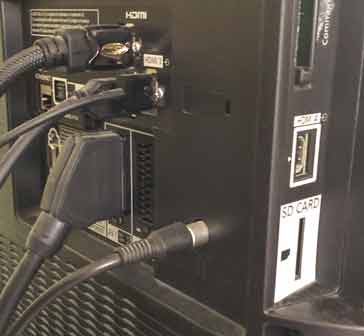Why Doesn't My TV Antenna Work Anymore
TV Antennas normally work well, but sometimes they stop working so we have outlined some reasons why they fail and some top tips to get the signal back.
Home » Antennas & Propagation » this page
TV antennas guides include:
Types of TV antenna
Buying a TV antenna
TV antenna direction alignment & pointing
TV transmitter finder app
TV antenna alignment meter
Buying TV antenna amplifier / booster
Indoor TV antenna & set-up
Satellite TV dish installation
How to wire a TV antenna socket
Why doesn't a TV antenna work any more
General antenna installation guides
Antenna installation guide
Attic installation
Antenna height
It often happens that TV antennas are installed and work well, but after a while their performance falls or even fails completely.
As a result, many people are left asking why their TV antenna or aerials don't work any more, seeking to find a reason for its failure.

In reality, there are many reasons why a TV antenna will stop working - some are simple and can be fixed very easily, but others may require a little more work to re-instate their performance and get them working satisfactorily.
Understanding the reasons why a TV antenna might stop working can help fix the issue, often without too much expense.
First step: review the TV antenna installation
Before making an rash decisions about what the issue might be, it is worth taking a step back and looking at what the possible reasons why the TV antenna has stopped working.
By working though a number of reasons why the antenna might have stopped working, it is possible to eliminate the causes one by one - sometimes it could be easy to fix, other times more difficult.
It would be a real shame an expensive investigation was undertaken, and possibly the antenna replaced, when the real reason the TV antenna had stopped working was for a really simple to fix cause.
Accordingly, it is worth checking the easy to fix problems first, and then move onto the more costly and difficult ones later.
We have assembled some of the reasons that we have come across before - even experienced some ourselves, but dependent upon the actual TV antenna installation, there could be other reasons.
Accordingly before embarking on any expensive fixes, it may be worth calling in someone to assess it before committing to any expenditure.
Effects of poor signal on a TV
With the old analogue TV signals, when an antenna failed or the performance fell, as the signal fell the background noise rose and this manifested itself as what was often termed "snow" on the screen.
With a digital signal, which is used by most TV transmissions these days, the degradation of the signal is rather different. It doesn't offer the "graceful degradation" that was experienced with the old analogue TV transmissions.
Instead for a digital television transmission a much sharper cut-off is seen. Often there will be a picture one minute and nothing the next. Often there will be more pixellation as the signal degrades, but there tends to be far more of a sharp transition between a good picture and then nothing.
Points to check
There are many things that can be checked to find out why a television antenna is not working.
As mentioned, it always pays to check the simple ideas first as they are easy to rectify if they are the cause of the issue, and it saves paying out on expensive repairs when they may not be needed.
Some of the issues may appear obvious, but they can catch out even experienced engineers, if they do not think of them at the time.
• Issues at the TV transmitter
Although TV broadcast stations are very reliable these days, this does not mean that they are immune from technical troubles.
Occasionally broadcast transmitters will go down and the televisions then will display the familiar "No Signal" message. It is worth waiting a little while of the signal suddenly disappears for no apparent reason.
Also many news reports that are done on location may suffer from poor signal quality and become pixellated, so it is worth waiting to see if that is the case.
Also with satellite reception, signal can be lost of there is very heavy rain present. This can sometimes be so intense and the clouds so dense with water that the signal can be lost.
• TV needs retuning
Another issue that can occur is that the TV set may need retuning. Dependent upon the country and the approach and technology adopted, stations may change channel and as a result the TV set may need retuning.
Although it may appear initially that the TV antenna or aerial has failed, this may not be the case. It could be that the TV set needs retuning - this can be initiated within the settings menu of the TV set.
Although some TCV sets may retune automatically when they find changes, others may not and this can cause a problem.
Accordingly, when looking at why a TV aerial has stopped working, this can often be one of the first things to check.
Even if you think it won't need doing, then there is nothing lost getting to to do an auto-retune and then that cause can be ruled out, or the reason for the TV antenna not working can be found.
• Antenna amplifier power lost
Many TV antennas have an antenna amplifier, often with a splitter to feed multiple televisions.
As amplifiers, whether they include a splitter or not, include an amplifier, this needs power. Sometimes this power is supplied directly from the television, but more often than not it needs to be provided externally.
Particularly for external amplifiers mounted on a mast where a minimum number of cables is advisable, the power is supplied through the coaxial cable. However an external power supply is used near the TV set. This is connected to the power line or mains supply and has the coaxial cable passing through it.
It is well worth checking that this is connected properly, both to the line power (mains power) and also to the coax cable. There may even be a small indicator lamp to indicate that the power is on correctly.
• TV on wrong input source
Another simple point that can easily prove to be confusing is that the television input may be set to the wrong input. Modern televisions have several video input sources and it is easy to change them.
It is very simple to check that the TV is on the right input source and whether there is actually a TV antenna problem.
• TV antenna plug or cable loose
One of the issues that often affects that can affect many items of electronic equipment can be the connectors for the interfacing cables falling out, or the connectors themselves deteriorating with use.

Often connectors that have a lot of flexing or general use suffer most and it can be a common source of reliability issues.
Although most television connectors do not suffer much flexing, vibration, etc, it is still possible they can accidentally be pulled out, or the cable in the connector can become displaced.
It is normally very easy to check that the connector is firmly plugged in, and that the connection of the cable to the connector appears intact.
If either of these is an issue it is likely to be very obvious and very easy to fix - it is worth a quick look behind te TV set to make sure everything is right.
• TV antenna damaged
External TV antennas not only experience the full force of the weather - wind, rain, snow, damp and many other aspects of the weather that can cause corrosion as well as applying mechanical stress, but they also provide an ideal perch for many birds!
Soem of the larger birds that perch on the antennas can be relatively large and over time they can cause damage to the antenna.
As a result of all these issues, it is not unusual for elements to fall off the antenna or for the antenna to change its direction, etc.
While it is possible to many antennas to be missing a part or more, without undue loss in performance, but especially if the fixings start to fail and it is directed in the wrong direction, then this can not only cause its performance to degrade, but it can also be a danger.
It is worth visually checking the antenna to see if all is well, and if not, then calling in a TV antenna specialist to resolve the problem.
• TV feeder degradation
it is often forgotten that the TV coax cable or feeder can degrade over time. There are several ways in which this can occur.
One is that there is a slow deterioration of the materials over time, even if it is held on good conditions, but this is not one of the major issues as it takes many years for this to occur.
One of the main issues is that moisture can enter the cable. Although any damage to the outer shield of the cable will let in moisture, the main area where moisture can enter is at the top where it connects to the antenna.
There is normally a protective housing where the connections are made, but driving rain, mist and the like will still enter the housing and the coax.
Over time, the moisture will penetrate down the coax, and any moisture here will tend to absorb the signal as well as causing corrosion on the conductors which will also cause the loss levels to rise.
In addition to this, long exposure to the sun can also cause the cable to deteriorate and hence give rise to increased levels of loss.
The loss levels from moisture entry and overall cable degradation will rise very gradually over time and often pass unnoticed until there is a tipping point when the signal will be too small for the TV to decipher it and pixellation will be seen, and eventually the picture will be lost.
As a result of this, the coax cable may well need replacing after some time.
These are just a few of the reasons why a television or TV antenna does not work after a while. It is worth checking the easy to fix reasons first before progressing to the more difficult and costly options.
By checking the various issues, it is possible to gain a good idea of what the issues with a TV antenna might be and how to fix them.
 Written by Ian Poole .
Written by Ian Poole .
Experienced electronics engineer and author.
More Antenna & Propagation Topics:
EM waves
Radio propagation
Ionospheric propagation
Ground wave
Meteor scatter
Tropospheric propagation
Antenna basics
Cubical quad
Dipole
Discone
Ferrite rod
Log periodic antenna
Parabolic reflector antenna
Phased array antennas
Vertical antennas
Yagi
Antenna grounding
Installation guidelines
TV antennas
Coax cable
Waveguide
VSWR
Antenna baluns
MIMO
Return to Antennas & Propagation menu . . .



